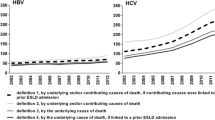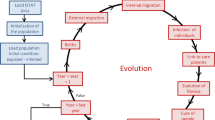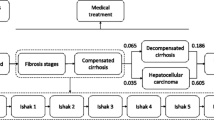Abstract
In this paper we propose two methods to give a first rough estimate of the actual number of hepatitis C virus (HCV)-infected individuals (prevalence) taking into account the notification rate of newly diagnosed infections (incidence of notification) and the size of the liver transplantation waiting list (LTWL) of patients with liver failure due to chronic HCV infection. Both approaches, when applied to the Brazilian HCV situation converge to the same results, that is, the methods proposed reproduce both the prevalence of reported cases and the LTWL with reasonable accuracy. We use two methods to calculate the prevalence of HCV that, as a first, and very crude approximation, assumes that the actual prevalence of HCV in Brazil is proportional to the reported incidence to the official notification system with a constant denoted \(\kappa \). In the paper we discuss the limitations and advantages of this assumption. With the two methods we calculated \(\kappa \), which reproduces both the reported incidence and the size of the LTWL. With the value of \(\kappa \) we calculated the prevalence I(a) (the integral of which resulted in 1.6 million people living with the infection in Brazil, most of whom unidentified). Other variables related to HCV infection (e.g., the distribution of the proportion of people aged a who got infected n years ago) can be easily calculated from this model. These new variables can then be measured and the model can be recursively updated, improving its accuracy.






Similar content being viewed by others
References
Ackerman Z, Ackerman E, Paltiel O (2000) Intrafamilial transmission of hepatitis C virus: a systematic review. J Viral Hepat 7(2):93–103
Amaku M, Coutinho FAB, Azevedo RS, Burattini MN, Lopez LF, Massad E (2003) Vaccination against rubella: analysis of the temporal evolution of the age-dependent force of infection and the effects of different contact patterns. Phys Rev E 67(5):051907
Burattini MN, Massad E, Rozman M, Azevedo RS, Carvalho HB (2000) Correlation between HIV and HCV in Brazilian prisoners: evidence for parenteral transmission inside prison. Revista de Saúde Pública 34(5):431–436
Chaib E, de Oliveira MCF, Galvao FHF, Silva FD, D’Albuquerque LAC, Massad E (2010) Theoretical impact of an anti-HCV vaccine on the annual number of liver transplantation. Med Hypotheses 75(3):324–327
Chaib E, Figueira ERR, Brunheroto A, Gatti AP, Fernandes DV, D’Albuquerque LAC (2014) Does the patient selection with the MELD score improve short-term survival in liver transplantation? Arquivos Brasileiros de Cirurgia Digestiva 26(4):324–327
Chisari VF (2005) Unscramblinghepatitis C virus-host interactions. Nature 436:930–932
Cox AL (2015) Global control of hepatitis C virus. Science 349(6250):790–791
Crofts N, Thompson S, Kaldor J (1999) Epidemiology of the hepatitis C virus. Technical Report Series No. 3, Communicable Diseases Network Australia and New Zealand
Custer B, Sullivan S, Hazlet TK, Iloeje U, Veensti V (2004) Global epidemiology of hepatitis virus. J Clin Gastroenterol 38(10):S158–S168
Giannini C, Bréchot C (2003) Hepatitis C virus biology. Cell Death Differ 10:S27–S38
Gower E, Estes C, Blach S, Razavi-Shearer K, Razavi H (2014) Global epidemiology and genotype distribution of the hepatitis C virus infection. J Hepatol 61:S45–S57
Hill A, Cooke G (2014) Hepatitis C can be cured globally, but at what cost? Science 345(6193):141–142
Holtzman D (2014) Hepatitis C. Yellow Book Traveler’s Health, CDC, Chap 3:1–4. http://wwwnc.cdc.gov/travel/yellowbook/2014/chapter-3-infectious-diseases-related-to-travel/hepatitis-c. Accessed in 26th May 2015
Hoofnagle JH (2002) Course and outcome of hepatitis C. Hepatology 36(5):S21–S29
Lauer GM, Walker BD (2001) Hepatitis C virus infection. N Engl J Med 345(1):41–52
Laurence SP (2000) Advances in the treatment of hepatitis C. Adv Intern Med 45:65–105
Massad E, Rozman M, Azevedo RS, Silveira ASB, Takey K, Yamamoto YI, Strazza L, Ferreira MMC, Carvalho HB, Burattini MN (1999) Seroprevalence of HIV, HCV and syphilis in Brazilian Prisoners: preponderance of parenteral transmission. Eur J Epidemiol 15(5):439–445
Massad E, Coutinho FAB, Chaib E, Burattini MN (2009) Cost-effectiveness analysis of a hypothetical hepatitis C vaccine compared to antiviral therapy. Epidemiol Infect 137(2):241–249
Nakano T, Lau GMG, Lau GML, Sgiyama M, Mizokami M (2012) An updated analysis of hepatitis C virus genotypes and subtypes based on the complete coding region. Liver Int 32(2):339–345
Reiche EM, Bonametti AM, Morimoto HK, Morimoto AA, Wiechemann SL, Matsuo T, Vissoci Reiche F, Vogler IH (2008) Epidemiological, immunological and virological characteristics, and disease progression of HIV-1/HCV-co-infected patients from a southern Brazilian population. Int J Mol Med 21:387–395
Romano CM, de Carvalho-Mello IMVG, Jamal LF, de Melo FL, Iamarino A, Motoki M, Pinho JRR, Holmes EC, Zanotto PMA, and the VGDN Consortium (2010) Social networks shape the transmission dynamics of hepatitis C virus. PLoS One 5(6):e11170. doi:10.1371/journal.pone.0011170
Rosen HR (2011) Chronic hepatitis C infection. N Engl J Med 364(25):2429–2438
Simmonds P (2013) The origin of hepatitis C virus. In: Bartenschlager R (ed) Hepatitis C virus: from molecular virology to antiviral therapy. Book Series: Current topics in microbiology and immunology, vol 369, pp 1–15
Shepard CW, Finelli L, Alter MJ (2005) Global epidemiology of hepatitis C virus infection. Lancet Infect Dis 5:558–567
Strazza L, Massad E, Azevedo RS, Carvalho HB (2007) Behavior associated with HIV and HCV infection in female prison inmates in Sao Paulo, Brazil. Cadernos de Saude Publica 23(1):197–205
Thein HH, Yi QL, Dore GJ, Krahn MD (2008) Estimation of stage-specific fibrosis progression rates in chronic hepatitis C virus infection: a meta-analysis and meta-regression. Hepatology 48(2):418–431
van den Hoek JAR, van Haastrescht JA, de Goudsmit J, Wolf F, Coutinho RA (1990) Prevalence, incidence and risk factors of hepatitis C virus infection among drug users in Amsterdam. J Infect Dis 162(4):823–826
Acknowledgments
This work was partially supported by grants from LIM01-HCFMUSP, FAPESP, CNPq and Ministry of Health of Brazil.
Author information
Authors and Affiliations
Corresponding author
Additional information
All the authors, with the exception of the corresponding, are listed alphabetically.
Appendices
Appendix 1: Calculating the Age of Infection from the Incidence Data of an Official Notification Systems
In the main text we calculate the proportion of individuals aged a who acquired the infection between 0 and \(\tau \), from Eq. (11). That equation is correct but, as we shall see in this appendix, it can be only an approximation of the notification data recorded in an official notification system. To see this let the time between 0 and \(\tau \) be divided in 1-year intervals. Then, Eq. (11) reads:
Therefore, from Eq. (3) of the main text the prevalence of individuals aged a, who acquired the infection between 0 and \(\tau \ (\tau <a)\) is naively given by
However, this is an overestimate because some individuals who acquired the infection between 0 and \(\tau -1\) may have already been notified before \(\tau -1\). To correct this, we have to exclude all individuals notified between 0 and \(\tau -1\):
(the calculations for orders greater than \(\kappa ^{2}\) are too involved to be included here).
If \(\kappa \) is small enough, then Eq. (11) of the main text is a good approximation.
Appendix 2: Generalizing the “Notification Rate” \(\kappa \)
In the main text we assumed \(\hbox {SINAN}(a)=\kappa I(a)\), that is, all infected individuals that are reported are so with the same “notification rate” \(\kappa \). In this appendix we relax this assumption and consider that there are two classes (as an example) of infected individuals that are reported with two different “notification rates” \(\kappa _1 \) and \(\kappa _2 \). Here we still keep the assumption that notification rates are age independent. In a future work we will relax this assumption.
Assuming that among the infected individuals there are two classes, reported differently, system (1) now reads:
Equation (3) of the main text becomes:
This can be generalized for n classes as follows
Both approaches described in the main text can now be applied to system (19). This will be done in a future publication when more epidemiological data are available.
Rights and permissions
About this article
Cite this article
Amaku, M., Burattini, M.N., Coutinho, F.A.B. et al. Estimating the Size of the HCV Infection Prevalence: A Modeling Approach Using the Incidence of Cases Reported to an Official Notification System. Bull Math Biol 78, 970–990 (2016). https://doi.org/10.1007/s11538-016-0170-4
Received:
Accepted:
Published:
Issue Date:
DOI: https://doi.org/10.1007/s11538-016-0170-4




